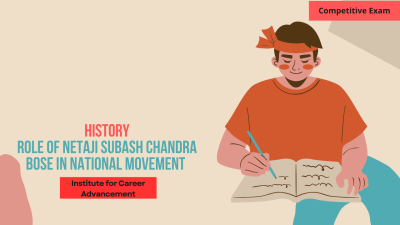Courses


 Compare
Compare
Congress Rule in the Provinces refers to the period between 1937 and 1939 when the Indian National Congress (INC) formed the government in several provinces of British India after winning a majority in the provincial elections held in 1937. This was the first time the Congress had significant political power in provincial governance. The Congress formed ministries in 8 out of 11 provinces, including key regions like Uttar Pradesh, Bengal, Madras, and Bombay. During this time, the Congress governments implemented various social and economic reforms, focusing on issues like education, land reforms, and economic welfare. However, the British government maintained control over areas like defense, foreign policy, and police. Tensions arose between the Congress ministries and the British colonial government, especially over the failure of constitutional reforms and British control over key areas. The Congress Rule in the Provinces came to an end in 1939 after the outbreak of World War II, when the British government involved India in the war without consulting the Congress, leading to the resignation of Congress ministries in protest. প্রদেশগুলিতে কংগ্রেস শাসন বলতে 1937 থেকে 1939 সালের মধ্যবর্তী সময়কে বোঝায় যখন 1937 সালে অনুষ্ঠিত প্রাদেশিক নির্বাচনে সংখ্যাগরিষ্ঠতা অর্জনের পর ভারতীয় জাতীয় কংগ্রেস (আইএনসি) ব্রিটিশ ভারতের বেশ কয়েকটি প্রদেশে সরকার গঠন করে। এই প্রথম প্রাদেশিক প্রশাসনে কংগ্রেসের উল্লেখযোগ্য রাজনৈতিক ক্ষমতা ছিল। কংগ্রেস উত্তরপ্রদেশ, বাংলা, মাদ্রাজ এবং বোম্বের মতো মূল অঞ্চলগুলি সহ 11টি প্রদেশের মধ্যে 8টিতে মন্ত্রিসভা গঠন করে। এই সময়ে, কংগ্রেস সরকারগুলি শিক্ষা, ভূমি সংস্কার এবং অর্থনৈতিক কল্যাণের মতো বিষয়গুলিকে কেন্দ্র করে বিভিন্ন সামাজিক ও অর্থনৈতিক সংস্কার বাস্তবায়ন করেছিল। তবে, ব্রিটিশ সরকার প্রতিরক্ষা, বৈদেশিক নীতি এবং পুলিশের মতো ক্ষেত্রগুলিতে নিয়ন্ত্রণ বজায় রেখেছিল। বিশেষ করে সাংবিধানিক সংস্কারের ব্যর্থতা এবং মূল ক্ষেত্রগুলিতে ব্রিটিশদের নিয়ন্ত্রণ নিয়ে কংগ্রেস মন্ত্রক এবং ব্রিটিশ ঔপনিবেশিক সরকারের মধ্যে উত্তেজনা দেখা দেয়। দ্বিতীয় বিশ্বযুদ্ধ শুরু হওয়ার পর 1939 সালে প্রদেশগুলিতে কংগ্রেস শাসনের অবসান ঘটে, যখন ব্রিটিশ সরকার কংগ্রেসের সাথে পরামর্শ না করেই ভারতকে যুদ্ধে জড়িত করে, যার ফলে প্রতিবাদে কংগ্রেসের মন্ত্রকগুলি পদত্যাগ করে।
0 Lessons
Hours

 Compare
Compare
The Civil Disobedience Movement (1930-1934) was a pivotal phase in India's struggle for independence, led by Mahatma Gandhi. It was a non-violent protest against British colonial rule, aiming to defy unjust laws and policies. The movement began with the famous Salt March (Dandi March) in 1930, where Gandhi and his followers walked 240 miles to produce salt from the sea, in defiance of the British monopoly on salt production. The movement spread across the country, with millions of Indians participating in non-violent protests, boycotts of British goods, and acts of civil disobedience. The British responded with arrests and repression, but the movement played a crucial role in mobilizing Indian masses and bringing international attention to the demand for Indian self-rule. আইন অমান্য আন্দোলন (1930-1934) মহাত্মা গান্ধীর নেতৃত্বে ভারতের স্বাধীনতা সংগ্রামের একটি গুরুত্বপূর্ণ পর্যায় ছিল। এটি ছিল ব্রিটিশ ঔপনিবেশিক শাসনের বিরুদ্ধে একটি অহিংস প্রতিবাদ, যার লক্ষ্য ছিল অন্যায্য আইন ও নীতিগুলিকে অমান্য করা। 1930 সালে বিখ্যাত লবণ যাত্রা (ডাণ্ডি যাত্রা) দিয়ে এই আন্দোলন শুরু হয়, যেখানে গান্ধী ও তাঁর অনুগামীরা লবণ উৎপাদনে ব্রিটিশ একচেটিয়া আধিপত্যের বিরোধিতা করে সমুদ্র থেকে লবণ উৎপাদনের জন্য 240 মাইল হেঁটেছিলেন। লক্ষ লক্ষ ভারতীয় অহিংস বিক্ষোভ, ব্রিটিশ পণ্য বর্জন এবং আইন অমান্যের কাজে অংশ নিয়ে এই আন্দোলন সারা দেশে ছড়িয়ে পড়ে। ব্রিটিশরা গ্রেপ্তার ও দমন-পীড়নের মাধ্যমে প্রতিক্রিয়া জানিয়েছিল, কিন্তু এই আন্দোলন ভারতীয় জনগণকে একত্রিত করতে এবং ভারতীয় স্বায়ত্তশাসনের দাবির প্রতি আন্তর্জাতিক দৃষ্টি আকর্ষণ করতে গুরুত্বপূর্ণ ভূমিকা পালন করেছিল।
0 Lessons
Hours

 Compare
Compare
The Nehru Report (1928) was a proposal for constitutional reform in India, drafted by a committee headed by Motilal Nehru. The report aimed to outline a framework for self-governance for India, in response to the Simon Commission, which had been criticized for excluding Indian representation. The Nehru Report recommended a Dominion status for India within the British Empire, a bicameral legislature, universal adult suffrage, and the protection of minority rights. However, it did not fully satisfy all groups, especially the Muslim League, which sought separate electorates for Muslims. The report highlighted the growing demand for constitutional change and laid the groundwork for future negotiations between India and Britain. নেহরু রিপোর্ট (1928) ছিল ভারতে সাংবিধানিক সংস্কারের একটি প্রস্তাব, যার খসড়া তৈরি করেছিল মতিলাল নেহরুর নেতৃত্বে একটি কমিটি। ভারতীয় প্রতিনিধিত্ব বাদ দেওয়ার জন্য সমালোচিত সাইমন কমিশনের প্রতিক্রিয়ায় এই প্রতিবেদনের লক্ষ্য ছিল ভারতের জন্য স্ব-শাসনের একটি কাঠামোর রূপরেখা তৈরি করা। নেহরু রিপোর্ট ব্রিটিশ সাম্রাজ্যের মধ্যে ভারতের জন্য একটি ডোমিনিয়ন মর্যাদা, একটি দ্বিদলীয় আইনসভা, সর্বজনীন প্রাপ্তবয়স্ক ভোটাধিকার এবং সংখ্যালঘু অধিকারের সুরক্ষার সুপারিশ করেছিল। তবে, এটি সমস্ত গোষ্ঠীকে, বিশেষত মুসলিম লীগকে সম্পূর্ণরূপে সন্তুষ্ট করতে পারেনি, যারা মুসলমানদের জন্য পৃথক নির্বাচকমণ্ডলী চেয়েছিল। প্রতিবেদনে সাংবিধানিক পরিবর্তনের ক্রমবর্ধমান দাবির কথা তুলে ধরা হয়েছে এবং ভারত ও ব্রিটেনের মধ্যে ভবিষ্যতের আলোচনার ভিত্তি স্থাপন করা হয়েছে।
0 Lessons
Hours

 Compare
Compare
The Simon Commission was a British-appointed body established in 1927 to review the political situation in India and recommend constitutional reforms. It was headed by Sir John Simon, but it faced widespread opposition because it had no Indian members, leading to accusations of disregarding Indian representation. Indian political leaders, including the Indian National Congress, strongly boycotted the commission. The protests against the Simon Commission, particularly the slogan "Simon Go Back", marked a significant step in the struggle for Indian independence, intensifying demands for full self-governance and eventually contributing to the rise of the Civil Disobedience Movement. সাইমন কমিশন ছিল ভারতের রাজনৈতিক পরিস্থিতি পর্যালোচনা এবং সাংবিধানিক সংস্কারের সুপারিশ করার জন্য 1927 সালে প্রতিষ্ঠিত একটি ব্রিটিশ-নিযুক্ত সংস্থা। এটির নেতৃত্বে ছিলেন স্যার জন সাইমন, কিন্তু এটির কোনও ভারতীয় সদস্য না থাকায় এটি ব্যাপক বিরোধিতার মুখোমুখি হয়েছিল, যার ফলে ভারতীয় প্রতিনিধিত্বকে অবজ্ঞা করার অভিযোগ ওঠে। ভারতীয় জাতীয় কংগ্রেস সহ ভারতীয় রাজনৈতিক নেতারা কমিশনকে তীব্রভাবে বর্জন করেছিলেন। সাইমন কমিশনের বিরুদ্ধে বিক্ষোভ, বিশেষত "সাইমন গো ব্যাক" স্লোগানটি ভারতের স্বাধীনতার সংগ্রামে একটি উল্লেখযোগ্য পদক্ষেপ হিসাবে চিহ্নিত হয়েছিল, যা পূর্ণ স্বায়ত্তশাসনের দাবি জোরদার করেছিল এবং শেষ পর্যন্ত আইন অমান্য আন্দোলনের উত্থানে অবদান রেখেছিল।
0 Lessons
Hours

 Compare
Compare
The Non-Cooperation Movement was a mass protest launched by Mahatma Gandhi in 1920, aimed at ending British colonial rule in India. It was a peaceful form of resistance where Indians were encouraged to boycott British goods, schools, courts, and services. The movement sought to assert Indian self-rule through nonviolent means, urging citizens to withdraw from the British-imposed institutions. The movement gained widespread support but was eventually called off in 1922 after the Chauri Chaura incident, where violent clashes led to the death of police officers. 1920 সালে ভারতে ব্রিটিশ ঔপনিবেশিক শাসনের অবসান ঘটানোর লক্ষ্যে মহাত্মা গান্ধী কর্তৃক অসহযোগ আন্দোলন একটি গণ প্রতিবাদ ছিল। এটি প্রতিরোধের একটি শান্তিপূর্ণ রূপ ছিল যেখানে ভারতীয়দের ব্রিটিশ পণ্য, স্কুল, আদালত এবং পরিষেবা বর্জন করতে উৎসাহিত করা হয়েছিল। আন্দোলনটি অহিংস উপায়ে ভারতীয় স্বায়ত্তশাসন দাবি করতে চেয়েছিল, নাগরিকদের ব্রিটিশ-আরোপিত প্রতিষ্ঠানগুলি থেকে সরে আসার আহ্বান জানিয়েছিল। আন্দোলনটি ব্যাপক সমর্থন অর্জন করে কিন্তু অবশেষে 1922 সালে চৌরি চৌরা ঘটনার পর বন্ধ হয়ে যায়, যেখানে সহিংস সংঘর্ষের ফলে পুলিশ কর্মকর্তাদের মৃত্যু হয়।
0 Lessons
Hours

 Compare
Compare
The First World War (1914-1918) significantly impacted the Indian Nationalist Movement. During the war, India contributed immensely in terms of soldiers and resources to support Britain’s war efforts, hoping for political concessions in return. However, after the war, Britain failed to honor promises of increased self-governance, leading to widespread disillusionment. The harsh Rowlatt Act (1919), which repressed Indian civil rights, further fueled anger. In response, nationalist leaders like Mahatma Gandhi shifted towards mass resistance, launching movements such as the Non-Cooperation Movement. The war and its aftermath thus catalyzed the growth of a more aggressive and mass-based struggle for India's independence. প্রথম বিশ্বযুদ্ধ (1914-1918) ভারতীয় জাতীয়তাবাদী আন্দোলনকে উল্লেখযোগ্যভাবে প্রভাবিত করেছিল। যুদ্ধের সময়, ভারত ব্রিটেনের যুদ্ধের প্রচেষ্টাকে সমর্থন করার জন্য সৈন্য ও সম্পদের ক্ষেত্রে প্রচুর অবদান রেখেছিল, বিনিময়ে রাজনৈতিক ছাড়ের আশা করেছিল। যাইহোক, যুদ্ধের পরে, ব্রিটেন বর্ধিত স্বায়ত্তশাসনের প্রতিশ্রুতি রক্ষা করতে ব্যর্থ হয়, যার ফলে ব্যাপক মোহভঙ্গ হয়। ভারতীয় নাগরিক অধিকার দমনকারী কঠোর রাউলাট আইন (1919) ক্ষোভকে আরও বাড়িয়ে তোলে। এর প্রতিক্রিয়ায়, মহাত্মা গান্ধীর মতো জাতীয়তাবাদী নেতারা অসহযোগ আন্দোলনের মতো আন্দোলন শুরু করে গণ প্রতিরোধের দিকে সরে যান। যুদ্ধ এবং এর পরিণতি এইভাবে ভারতের স্বাধীনতার জন্য আরও আক্রমণাত্মক এবং গণ-ভিত্তিক সংগ্রামের বিকাশকে অনুঘটক করেছিল।
0 Lessons
Hours

 Compare
Compare
The Era of Militant Nationalism in India refers to a period during the late 19th and early 20th centuries when nationalist movements became more aggressive and confrontational against British colonial rule. It followed the relatively moderate phase of the Indian National Congress and was marked by the rise of leaders and organizations advocating for direct action, self-rule, and the use of force if necessary. This era saw the emergence of figures like Subhas Chandra Bose, Lala Lajpat Rai, and Bal Gangadhar Tilak, who believed in the need for a more radical approach to achieve Indian independence. It included movements like the Swadeshi Movement (1905) and the Ghadar Party, and was characterized by the growing use of protests, boycotts, and revolutionary activities. This phase laid the groundwork for the more extensive national struggle for freedom in the 20th century. ভারতে উগ্র জাতীয়তাবাদের যুগ 19 শতকের শেষের দিকে এবং 20 শতকের গোড়ার দিকে এমন একটি সময়কে বোঝায় যখন জাতীয়তাবাদী আন্দোলনগুলি ব্রিটিশ ঔপনিবেশিক শাসনের বিরুদ্ধে আরও আক্রমণাত্মক এবং সংঘাতমূলক হয়ে ওঠে। এটি ভারতীয় জাতীয় কংগ্রেসের তুলনামূলকভাবে মধ্যপন্থী পর্যায় অনুসরণ করে এবং প্রত্যক্ষ পদক্ষেপ, স্ব-শাসন এবং প্রয়োজনে শক্তি প্রয়োগের পক্ষে ওকালতি করা নেতা ও সংগঠনগুলির উত্থান দ্বারা চিহ্নিত হয়েছিল। এই যুগে সুভাষ চন্দ্র বসু, লালা লাজপত রায় এবং বাল গঙ্গাধর তিলকের মতো ব্যক্তিত্বের উত্থান ঘটেছিল, যারা ভারতের স্বাধীনতা অর্জনের জন্য আরও আমূল পদ্ধতির প্রয়োজনীয়তায় বিশ্বাস করতেন। এতে স্বদেশী আন্দোলন (1905) এবং গদর পার্টির মতো আন্দোলন অন্তর্ভুক্ত ছিল এবং প্রতিবাদ, বয়কট এবং বিপ্লবী কার্যকলাপের ক্রমবর্ধমান ব্যবহার দ্বারা চিহ্নিত করা হয়েছিল। এই পর্যায়টি বিংশ শতাব্দীতে স্বাধীনতার জন্য আরও ব্যাপক জাতীয় সংগ্রামের ভিত্তি স্থাপন করে।
0 Lessons
Hours

 Compare
Compare
The Cripps Mission was a British initiative during World War II, led by Sir Stafford Cripps, sent to India in 1942 to secure Indian support for the British war effort. The mission aimed to offer constitutional reforms and promises of greater self-governance in return for Indian cooperation. However, the proposals were seen as inadequate by Indian leaders, especially the Indian National Congress and the Muslim League. The mission failed because it did not grant immediate full independence and was perceived as a tactic to maintain British control. This failure led to increased dissatisfaction and the launch of the Quit India Movement in the same year. ক্রিপস মিশন ছিল দ্বিতীয় বিশ্বযুদ্ধের সময় স্যার স্টাফোর্ড ক্রিপসের নেতৃত্বে একটি ব্রিটিশ উদ্যোগ, যা 1942 সালে ব্রিটিশ যুদ্ধের প্রচেষ্টায় ভারতীয় সমর্থন সুরক্ষিত করার জন্য ভারতে পাঠানো হয়েছিল। এই মিশনের লক্ষ্য ছিল ভারতীয় সহযোগিতার বিনিময়ে সাংবিধানিক সংস্কার এবং বৃহত্তর স্বায়ত্তশাসনের প্রতিশ্রুতি প্রদান করা। তবে, ভারতীয় নেতারা, বিশেষ করে ভারতীয় জাতীয় কংগ্রেস এবং মুসলিম লীগ এই প্রস্তাবগুলিকে অপর্যাপ্ত বলে মনে করেছিলেন। মিশনটি ব্যর্থ হয়েছিল কারণ এটি অবিলম্বে পূর্ণ স্বাধীনতা দেয়নি এবং ব্রিটিশ নিয়ন্ত্রণ বজায় রাখার কৌশল হিসাবে বিবেচিত হয়েছিল। এই ব্যর্থতার ফলে অসন্তোষ বৃদ্ধি পায় এবং একই বছরে ভারত ছাড়ো আন্দোলন শুরু হয়।
0 Lessons
Hours

 Compare
Compare
Netaji Subhas Chandra Bose was a prominent leader in India's struggle for independence, known for his radical approach and strong leadership. He advocated for complete independence from British rule and sought international support to achieve this goal. Bose famously led the Indian National Army (INA), which fought alongside the Japanese during World War II against the British in Southeast Asia. His leadership inspired millions and brought a new dimension to India's freedom movement, focusing on armed resistance. His slogan "Give me blood, and I will give you freedom" galvanized nationalists and earned him a lasting place in India's history as a symbol of courage and patriotism. নেতাজি সুভাষ চন্দ্র বসু ভারতের স্বাধীনতা সংগ্রামের একজন বিশিষ্ট নেতা ছিলেন, যিনি তাঁর মৌলবাদী দৃষ্টিভঙ্গি এবং দৃঢ় নেতৃত্বের জন্য পরিচিত ছিলেন। তিনি ব্রিটিশ শাসন থেকে সম্পূর্ণ স্বাধীনতার পক্ষে ছিলেন এবং এই লক্ষ্য অর্জনের জন্য আন্তর্জাতিক সমর্থন চেয়েছিলেন। বসু বিখ্যাতভাবে ইন্ডিয়ান ন্যাশনাল আর্মির (আইএনএ) নেতৃত্ব দিয়েছিলেন যা দ্বিতীয় বিশ্বযুদ্ধের সময় জাপানিদের পাশাপাশি দক্ষিণ-পূর্ব এশিয়ায় ব্রিটিশদের বিরুদ্ধে লড়াই করেছিল। তাঁর নেতৃত্ব লক্ষ লক্ষ মানুষকে অনুপ্রাণিত করেছিল এবং সশস্ত্র প্রতিরোধের দিকে মনোনিবেশ করে ভারতের স্বাধীনতা আন্দোলনে একটি নতুন মাত্রা নিয়ে এসেছিল। তাঁর স্লোগান "আমাকে রক্ত দিন, আমি আপনাকে স্বাধীনতা দেব" জাতীয়তাবাদীদের অনুপ্রাণিত করেছিল এবং সাহস ও দেশপ্রেমের প্রতীক হিসাবে ভারতের ইতিহাসে একটি স্থায়ী স্থান অর্জন করেছিল।
0 Lessons
Hours